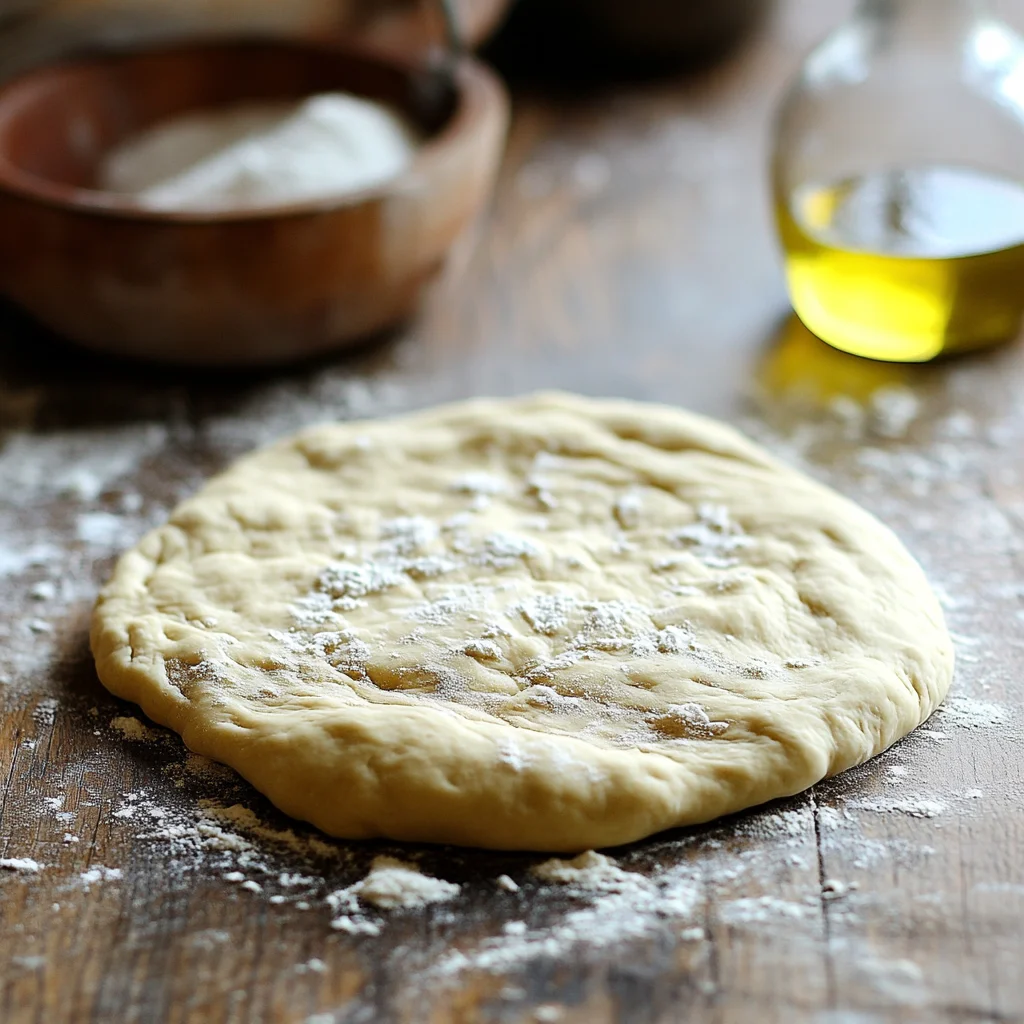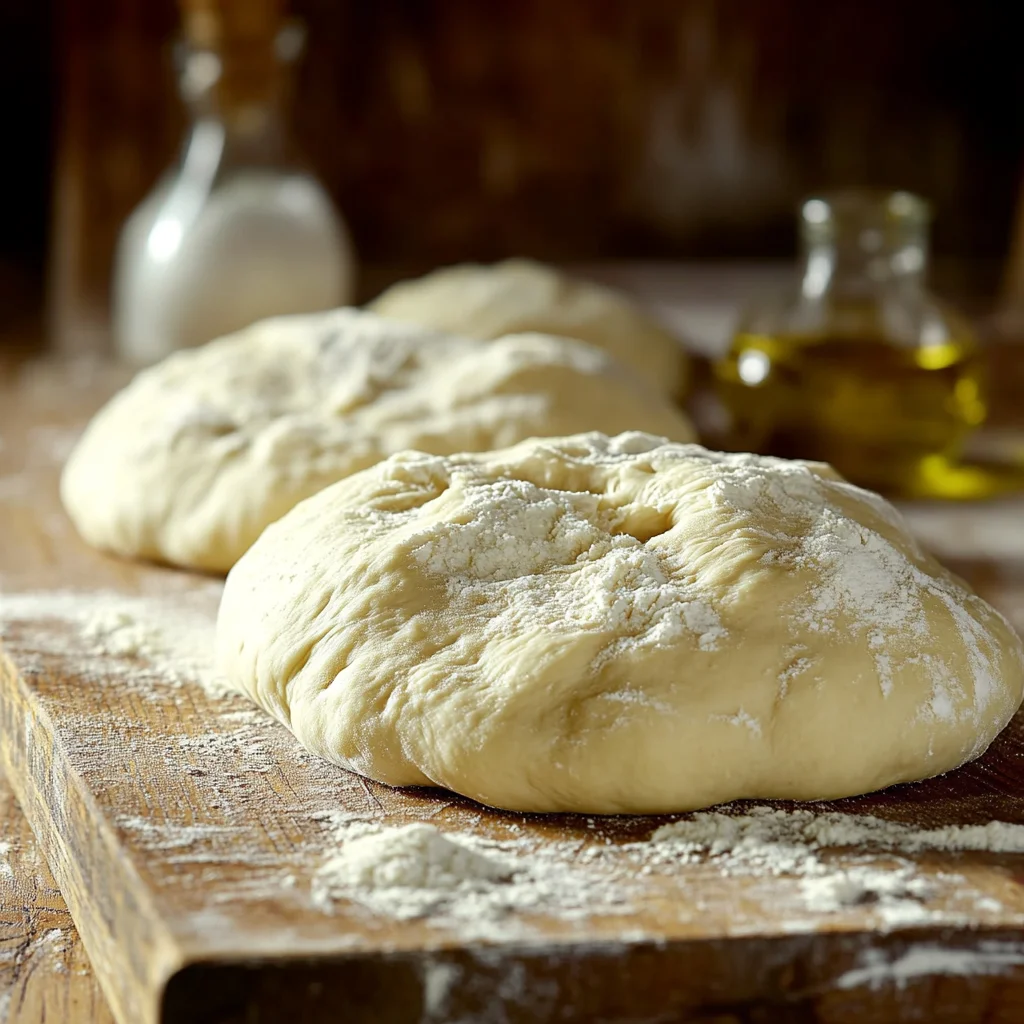Pizza is universally loved, but not all pizza is created equal. If you’re aiming for the authentic Italian experience, one of the key ingredients you need to get right is the dough. And when it comes to making the best pizza dough, using 00 flour can take your homemade pizza to the next level. This pizza dough recipe using 00 flour is designed to create a light, crispy, and slightly chewy crust, which is why it’s favored by top pizza chefs around the world.
For a soft and buttery bread experience, try this Milk Brioche Recipe.
In this article, we’ll walk you through the process of making the perfect pizza dough recipe using 00 flour, why 00 flour is essential for authentic pizza, and how you can easily customize the recipe to suit your preferences. Whether you’re a seasoned cook or a beginner, following this guide will help you make a pizza crust that is both crispy and flavorful.
Benefits and Advantages of Pizza Dough Using 00 Flour
Before jumping into the recipe, let’s explore why pizza dough made using 00 flour is the gold standard for making restaurant-quality pizza. 00 flour’s fine texture and high performance in high-heat ovens make it the perfect choice for this pizza dough recipe. You’ll see how this flour can transform your pizza into an authentic Italian experience.
1. Perfect Texture for Pizza Crust
One of the most significant benefits of using 00 flour in your pizza dough is the texture it creates. 00 flour is finely ground, giving it a silky texture that results in a dough that’s smooth and easy to work with. This fine grind produces a crust that is crispy on the outside yet soft and chewy on the inside, which is exactly what you want in a Neapolitan pizza.
The crust’s elasticity allows it to stretch and puff slightly, creating those characteristic air bubbles that make the pizza lighter and more enjoyable to eat. Because 00 flour has a lower gluten content than bread flour, it’s less likely to produce a tough, chewy crust.
2. Better for High-Heat Cooking
If you’re serious about making pizza at home, especially in a pizza oven or on a pizza stone, you’ll want to use 00 flour. This flour is specially designed for high-heat cooking, which is typical of wood-fired pizza ovens. While all-purpose flour can burn at the high temperatures used to cook pizza (around 800°F), 00 flour performs beautifully, helping the dough cook evenly without becoming overly crispy or burnt.
For home cooks using regular ovens, 00 flour can still provide excellent results. It allows you to achieve that classic pizza texture, even if your oven doesn’t reach the extreme temperatures of a professional pizza oven.
Read about why 00 flour is ideal for pizza ovens on Pizza Today, which explains why it’s the best flour for pizza ovens.
3. Creates Authentic Neapolitan Pizza
If you’ve ever wondered why pizzas made in Italy (especially in Naples) taste different from those made elsewhere, it’s often due to the ingredients—starting with the flour. 00 flour is traditionally used in Neapolitan pizza because of its fine texture, high protein content, and low gluten. This combination results in a pizza crust that is thin, soft, and perfectly balanced between crisp and chewy.
By using 00 flour in your homemade dough, you’re one step closer to recreating that authentic Italian pizza experience right in your kitchen.
For more creative pizza toppings, you might also enjoy this Sweet Tomatoes Chimichurri Pizza Recipe for a flavorful twist on your pizza night.
Discover 00 flour’s benefits for authentic pizza on Serious Eats for authentic texture and flavor.
4. Versatile for Other Baked Goods
While this article focuses on pizza dough, 00 flour isn’t limited to pizza alone. This finely ground flour is versatile and can also be used in other recipes like fresh pasta, bread, and even pastries. Its soft texture and low gluten content make it ideal for a wide range of baked goods where a delicate crumb is desired. So, once you’ve mastered pizza dough with 00 flour, you can experiment with other recipes as well!
Ingredients for the Best Pizza Dough with 00 Flour
To make the best pizza dough, it’s essential to use high-quality ingredients. While pizza dough only requires a few basic ingredients, the type and quality of these ingredients can have a significant impact on the final result. Here’s an overview of the essential ingredients you’ll need for this recipe.
Essential Ingredients for Pizza Dough Recipe Using 00 Flour

- 3 ½ cups (500g) 00 flour: The star of the show, 00 flour is what gives this dough its signature texture and elasticity. You can find 00 flour at most specialty grocery stores or order it online.
- 1 teaspoon active dry yeast: Yeast is what gives the dough its rise and airy texture. Make sure your yeast is fresh to ensure your dough rises properly.
- 1 teaspoon sugar: Sugar helps activate the yeast and adds a slight sweetness to the dough.
- 1 ½ cups warm water: Water hydrates the dough and helps the yeast work its magic. Make sure the water is warm, but not hot, to avoid killing the yeast.
- 2 teaspoons salt: Salt adds flavor to the dough and helps strengthen the gluten structure.
- 2 tablespoons olive oil: Olive oil adds flavor and helps keep the dough soft and pliable.
Why 00 Flour Is Crucial
As we’ve already discussed, 00 flour is the key ingredient that gives the dough its smooth texture and authentic taste. Its low protein content (usually around 8-12%) means that it forms just the right amount of gluten, resulting in a dough that is stretchy and elastic, without being tough.
The fineness of the flour also allows for easy rolling and shaping, which is crucial when making thin-crust pizzas. This type of flour absorbs water differently than other flours, so be mindful when mixing and kneading your dough. You may find that it requires slightly more or less water depending on the humidity and other environmental factors.
Customizing Your Pizza Dough Using 00 Flour for Dietary Needs
Learn how to adapt the pizza dough recipe using 00 flour to accommodate gluten-free, vegan, or low-sodium diets while keeping the flavor and texture intact.
Gluten-Free Option
- Use gluten-free flour blend: To make a gluten-free version of this pizza dough, you can substitute a gluten-free flour blend that is specifically formulated for pizza or bread dough. Be sure to follow the packaging instructions, as gluten-free doughs often require different handling and hydration than traditional dough.
- For gluten-free pizza lovers, explore this gluten-free pizza crust recipe on King Arthur Baking, offering insights into making a delicious gluten-free pizza crust.
Vegan Option
- Skip the sugar and oil: This pizza dough is already nearly vegan, but to make it fully vegan, you can omit the sugar (or replace it with agave or maple syrup) and use a light vegetable oil instead of olive oil.
Low-Sodium Option
- Reduce or omit the salt: While salt is important for flavor, you can reduce the amount to suit your dietary needs. If you’re on a low-sodium diet, simply reduce the salt by half or omit it entirely. Keep in mind that the flavor will be slightly different, but the dough will still rise and bake well.
Step-by-Step Guide: How to Make Pizza Dough with 00 Flour
Follow this step-by-step guide to make your own pizza dough recipe using 00 flour at home. These instructions will ensure you get the best results with an authentic Italian crust.
First Step: Activate the Yeast
In a small bowl, combine the warm water (about 110°F or 45°C), sugar, and yeast. Stir gently and let the mixture sit for 5-10 minutes, or until it becomes frothy. This step is essential for ensuring that the yeast is active and will give the dough a good rise.
Second Step: Combine the Dry Ingredients
In a large mixing bowl, combine the 00 flour and salt. Stir the dry ingredients together with a whisk or spoon to ensure that the salt is evenly distributed throughout the flour.
Third Step: Add the Wet Ingredients
Once the yeast has been activated, pour the yeast mixture into the bowl with the dry ingredients. Add the olive oil and begin to mix everything together. You can use a wooden spoon or a stand mixer fitted with a dough hook. Mix until the dough begins to come together.
Fourth Step: Knead the Dough
Turn the dough out onto a lightly floured surface and begin kneading. If you’re using a stand mixer, let it knead the dough on a low setting for about 5-7 minutes. If you’re kneading by hand, do so for about 10 minutes. The dough should be smooth, elastic, and slightly tacky but not sticky.
As you knead, you’ll notice how easy the dough is to work with thanks to the fine texture of the 00 flour. The dough will gradually become more elastic and pliable, which is a good sign that the gluten is developing.
For more tips on achieving the perfect pizza texture, check out this Tomato Asparagus Pasta Recipe, which pairs wonderfully with a crisp pizza base.
Fifth Step: Let the Dough Rise
Once the dough has been kneaded, shape it into a ball and place it in a lightly oiled bowl. Cover the bowl with a damp kitchen towel or plastic wrap and let the dough rise in a warm, draft-free area for about 1-2 hours, or until it has doubled in size.
If you’re short on time, you can let the dough rise in a slightly warm oven (around 100°F or 40°C) to speed up the process. Alternatively, you can refrigerate the dough for a slower rise, which can help develop more complex flavors. Just be sure to bring the dough back to room temperature before shaping it.
Sixth Step: Shape the Dough
Once the dough has risen, punch it down to release the excess gas and turn it out onto a floured surface. Divide the dough into 2-3 equal portions, depending on how large you want your pizzas to be. Roll each portion into a ball and let them rest for 10-15 minutes.
To shape the dough, use your hands or a rolling pin to gently flatten each dough ball into a round pizza crust. The dough should be thin in the center with slightly thicker edges to form the crust. If the dough springs back as you shape it, let it rest for a few more minutes to relax the gluten.
Seventh Step: Preheat the Oven and Bake
Preheat your oven to its highest setting (usually around 500°F or 260°C) and place a pizza stone or baking sheet in the oven to preheat. If you have a pizza oven, even better! Once the oven is preheated, transfer the shaped dough to a piece of parchment paper or a pizza peel dusted with flour or cornmeal.
Top the dough with your favorite sauce, cheese, and toppings, then carefully transfer it to the preheated stone or baking sheet. Bake for 8-10 minutes, or until the crust is golden and the cheese is bubbly and slightly browned.
Advanced Tips for Perfecting Your Pizza Dough Using 00 Flour
Ready to take your pizza-making skills to the next level? Explore these advanced tips for perfecting your pizza dough using 00 flour for even better results.
Cold Fermentation for Better Flavor
For an even more flavorful dough, try cold fermenting the dough. After mixing and kneading, place the dough in the fridge for 24-72 hours. This slow fermentation process allows the yeast to develop more complex flavors, resulting in a tastier crust. Just remember to bring the dough back to room temperature before baking.
Add Herbs or Spices to the Dough
To add extra flavor to your dough, try mixing herbs or spices directly into the flour. Dried oregano, garlic powder, or even red pepper flakes can give your crust a unique flavor that pairs well with various toppings.
Experiment with Toppings
While classic toppings like mozzarella, tomatoes, and basil are always a hit, don’t be afraid to experiment with different toppings. Try prosciutto and arugula for a gourmet touch, or go bold with goat cheese, caramelized onions, and figs. The possibilities are endless!
For a rich, creamy complement to your pizza, try this Creamy Chicken Alfredo Bake Recipe as a side dish.
How to Store Pizza Dough: Best Practices
Pizza dough made with 00 flour stores well and can be frozen for future use. Here’s how to store and save your dough for later.
Refrigeration
If you’re not using all of the dough immediately, you can store the extra portions in the fridge for up to 3 days. Simply place the dough in an airtight container or wrap it in plastic wrap. Be sure to let it come to room temperature before rolling it out and baking.
Freezing
Pizza dough freezes beautifully, allowing you to have homemade pizza dough on hand whenever you crave it. To freeze, wrap each dough ball tightly in plastic wrap and place it in a freezer-safe bag. It will keep for up to 3 months. To use, thaw the dough in the fridge overnight and bring it to room temperature before baking.
Nutritional Value of Pizza Dough Using 00 Flour
The nutritional content of pizza dough will vary slightly depending on the specific ingredients you use, but here’s a general breakdown of the nutritional value per slice of pizza dough made with 00 flour (based on a recipe yielding 8 slices):
- Calories: 160
- Protein: 4g
- Carbohydrates: 30g
- Fat: 2g
- Fiber: 1g
This makes pizza dough a relatively low-calorie base for your pizza, allowing you to focus on creating a balanced meal with healthy toppings like vegetables and lean proteins.
Frequently Asked Questions About Pizza Dough Using 00 Flour
Can I Use All-Purpose Flour Instead of 00 Flour?
Yes, you can use all-purpose flour if you don’t have 00 flour on hand, but the texture of the dough will be slightly different. All-purpose flour has a higher gluten content, which may result in a dough that’s chewier and less elastic than dough made with 00 flour. If possible, try to find 00 flour for the best results.
How Long Should I Knead Pizza Dough?
Pizza dough should be kneaded for about 7-10 minutes. You’ll know the dough is ready when it’s smooth, elastic, and slightly tacky to the touch. Be careful not to over-knead, as this can make the dough too tough.
Do I Need a Pizza Stone to Make Pizza at Home?
While a pizza stone helps create a crispier crust by distributing heat evenly, it’s not necessary. You can bake pizza on a regular baking sheet, although you may not achieve the same level of crispiness.
Can I Make Pizza Dough Ahead of Time?
Yes! You can make pizza dough ahead of time and store it in the fridge for up to 3 days or freeze it for up to 3 months. Just be sure to bring the dough to room temperature before rolling it out and baking.
Conclusion
Making pizza dough using 00 flour is the key to creating authentic, delicious pizza at home. With its perfect texture, elasticity, and ability to withstand high temperatures, 00 flour produces a pizza crust that’s crispy on the outside and soft and chewy on the inside.
Whether you’re a pizza-making novice or an experienced home cook, this recipe is easy to follow and can be customized to suit your preferences. With a few simple ingredients and some practice, you’ll be able to enjoy homemade pizza that rivals your favorite pizzeria. So, roll up your sleeves, grab some 00 flour, and get ready to make the best pizza dough ever!

